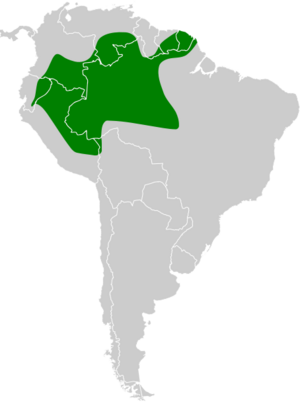Rufous-tailed xenops facts for kids
The rufous-tailed xenops (Microxenops milleri) is a small bird from the ovenbird family called Furnariidae. You can find it in many South American countries. These include Bolivia, Brazil, Colombia, Ecuador, Guyana, Peru, Suriname, and Venezuela. It might also live in French Guiana.
Quick facts for kids Rufous-tailed xenops |
|
|---|---|
 |
|
| Conservation status | |
| Scientific classification | |
| Genus: |
Microxenops
|
| Species: |
milleri
|
 |
|
Contents
About the Rufous-tailed Xenops Name
The rufous-tailed xenops was first placed in a group called Microxenops. Later, in the 1950s, it was moved into the Xenops group.
However, in 2011, scientists looked at the bird's DNA. They found it did not fit with the Xenops group. So, it was moved back to its original Microxenops group.
This bird is the only type in its Microxenops group. It does not have any different kinds or subspecies.
What Does the Rufous-tailed Xenops Look Like?
The rufous-tailed xenops is a small bird. It is about 10 to 11 cm (3.9 to 4.3 in) long. It weighs about 12 to 13 g (0.42 to 0.46 oz). It has a thin, straight beak. Male and female birds look the same.
Adult birds have a mostly blackish-brown face. They have a light buff stripe above their eye. Their head is blackish-brown with golden-buff streaks. Their back is dark reddish-brown with wide buff stripes. These stripes fade towards their lower back.
Their rump and upper tail feathers are reddish. Their tail is a dark reddish color. Their wing feathers are blackish with reddish-brown edges. Their flight feathers are blackish with a wide reddish band.
The bird's chin and throat are pale yellowish-buff. Its throat has dark olive spots and stripes. Its chest is bright buff with thin, dark olive-brown streaks. These streaks fade towards its belly. Its belly is bright golden-buff with light brownish streaks. The feathers under its tail are bright buff with light brownish streaks.
Its eyes are brown to dark brown. Its upper beak is black to brownish. Its lower beak is blue-gray. Its legs and feet are yellowish-brown to olive.
Where the Rufous-tailed Xenops Lives
The rufous-tailed xenops lives in many parts of South America. You can find it from southeastern Colombia. It goes east through southern Venezuela and southern Guyana. It also lives in Suriname. It goes south through eastern Ecuador and Peru. It reaches northwestern Bolivia. From there, it goes east into the Amazon region of Brazil.
It might also be in French Guiana. But there are only a few unconfirmed sightings there. So, bird experts are not sure yet.
Habitat of the Rufous-tailed Xenops
This bird lives in tropical lowland forests. It likes evergreen forests. It prefers terra firme forests. These are forests on higher, drier ground. But it also lives in várzea forests. These are forests that flood.
It usually lives below 600 m (2,000 ft) in height. But it can be found higher up. It reaches 1,100 m (3,600 ft) in Colombia. It can also be found up to 1,000 m (3,300 ft) in Ecuador.
How the Rufous-tailed Xenops Behaves
Movement and Travel
The rufous-tailed xenops stays in the same area all year. It does not migrate.
What the Rufous-tailed Xenops Eats
The rufous-tailed xenops eats arthropods. These are small creatures like insects and spiders. Scientists have seen it eat Orthoptera, which include grasshoppers and crickets.
It often looks for food alone. But it also joins groups of different bird species that feed together. It usually searches for food in the middle and upper parts of the forest trees. It picks prey from bark, leaves, and moss. It moves along thin branches and vines. It can even hang upside down to reach the bottom of branches.
Reproduction and Life Cycle
Scientists do not know much about how the rufous-tailed xenops breeds.
Vocalization and Sounds
The song of the rufous-tailed xenops is a short, fast trill. It is high-pitched. The song gets louder and then softer. It also rises and falls. Its call has not been described by scientists yet.
Status of the Rufous-tailed Xenops
The IUCN (International Union for Conservation of Nature) has checked on the rufous-tailed xenops. They say it is a species of "Least Concern." This means it is not currently in danger of disappearing.
The bird lives across a very large area. Even though its exact population size is unknown, experts believe it is stable. No immediate threats have been found for this bird. It is considered rare in some places and fairly common in others. It seems to be spread out in patches. It lives in many protected areas, which helps keep it safe.


